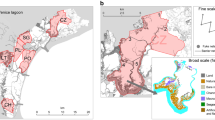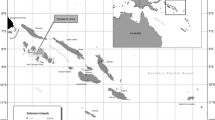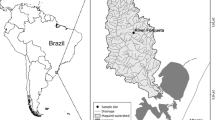Abstract
Human pressures on ecosystems from landscape transformation and harvesting can result in changes to body size and functional traits of affected species. However, these effects remain very poorly understood in many settings. Here we examine whether and how fishing and the attributes of coastal seascapes can operate in concert to change the body size and functional traits of the giant mud crab, Scylla serrata; a prized fisheries species. We captured 65 legal sized (> 15 cm carapace width) male giant mud crabs from 13 estuaries in southeast Queensland, Australia. These estuaries span a wide range of fishing and catchment landscape transformation intensity. We made a total of 9000 external morphometric measurements in the study. There was a distinct effect of estuarine landscape context on body size, with the largest individuals captured from systems with bigger inlets and lower extent of intertidal flats. Variation in functional traits was most often associated with variation in fishing pressure and human population size in the catchment. Crabs from areas with less commercial fishing pressure and lower human populations in the catchment had the largest chelipeds. We also found effects of urbanisation (negative correlations), intertidal flats (inconsistent effects) and mangrove extent (positive correlations) on the size of some functional traits. Our results show that human pressures can have sublethal effects on animals in estuaries that alter body size and functional traits. These phenotypic responses might have consequences for the fitness and ecological roles of targeted species, and the yields of fisheries catches.





Similar content being viewed by others
References
Acevedo-Whitehouse, K., and A.L. Duffus. 2009. Effects of environmental change on wildlife health. Philosophical Transactions of the Royal Society of London. Series B, Biological Sciences 364 (1534): 3429–3438.
Adams, D., Collyer, M., and Kaliontzopoulou, A.. 2018. Geometric morphometric analyses of 2D/3D landmark data.
Alberts-Hubatsch, H., S.Y. Lee, J.-O. Meynecke, K. Diele, I. Nordhaus, and M. Wolff. 2016. Life-history, movement, and habitat use of Scylla serrata (Decapoda, Portunidae): Current knowledge and future challenges. Hydrobiologia 763 (1): 5–21.
Anderson, M.J., R.N. Gorley, and K.R. Clarke. 2008. PERMANOVA+ for primer: Guide to software and statistical methods. Plymouth: PRIMER-E Ltd..
Australian Bureau of Statistics. 2017. 2016 Australian census data. Canberra: Australian Bureau of Statistics.
Australian Bureau of Statistics, Canberra. 2016. Queensland population growth. In Regional population growth, Australia, 2009–2010. Australia: Canberra.
Barbier, E.B., S.D. Hacker, C. Kennedy, E.W. Koch, A.C. Stier, and B.R. Silliman. 2011. The value of estuarine and coastal ecosystem services. Ecological Monographs 81 (2): 169–193.
Barton, K. 2018. MuMIN: multi-model inference. R package version 1.42.1.
Beattie, C.L., K.A. Pitt, and R.M. Connolly. 2012. Both size and gender of mud crabs influence the outcomes of interference interactions. Journal of Experimental Marine Biology and Ecology 434: 1–6.
Becker, A., M. Holland, J.A. Smith, and I.M. Suthers. 2016. Fish movement through an estuary mouth is related to tidal flow. Estuaries and Coasts 39 (4): 1199–1207.
Bishop, M.J., M. Mayer-Pinto, L. Airoldi, L.B. Firth, R.L. Morris, L.H.L. Loke, S.J. Hawkins, L.A. Naylor, R.A. Coleman, S.Y. Chee, and K.A. Dafforn. 2017. Effects of ocean sprawl on ecological connectivity: Impacts and solutions. Journal of Experimental Marine Biology and Ecology 492: 7–30.
Bonine, K.M., E.P. Bjorkstedt, K.C. Ewel, and M. Palik. 2008. Population characteristics of the mangrove crab Scylla serrata (Decapoda: Portunidae) in Kosrae, Federated States of Micronesia: Effects of harvest and implications for management. Pacific Science 62 (1): 1–19.
Cardinale, B.J., J.E. Duffy, A. Gonzalez, D.U. Hooper, C. Perrings, P. Venail, A. Narwani, G.M. Mace, D. Tilman, and D.A. Wardle. 2012. Biodiversity loss and its impact on humanity. Nature 486 (7401): 59–67.
Clark, M.R., F. Althaus, T.A. Schlacher, A. Williams, D.A. Bowden, and A.A. Rowden. 2015. The impacts of deep-sea fisheries on benthic communities: A review. ICES Journal of Marine Science 73: i51–i69.
Cloern, J.E., P.C. Abreu, J. Carstensen, L. Chauvaud, R. Elmgren, J. Grall, H. Greening, J.O. Johansson, M. Kahru, E.T. Sherwood, J. Xu, and K. Yin. 2016. Human activities and climate variability drive fast-paced change across the world's estuarine-coastal ecosystems. Global Change Biology 22 (2): 513–529.
Dumas, P., M. Léopold, L. Frotté, and C. Peignon. 2012. Mud crab ecology encourages site-specific approaches to fishery management. Journal of Sea Research 67 (1): 1–9.
EHMP. 2019. Ecosystem Health Monitoring Program. https://hlw.org.au/project/ecosystem-health-monitoring-program/. Accessed Jun 2019.
Elliott, M., D. Burdon, J.P. Atkins, A. Borja, R. Cormier, V.N. de Jonge, and R.K. Turner. 2017. “And DPSIR begat DAPSI(W)R(M)!” - A unifying framework for marine environmental management. Marine Pollution Bulletin 118 (1-2): 27–40.
Elliott, M., A.K. Whitfield, I.C. Potter, S.J.M. Blaber, D.P. Cyrus, F.G. Nordlie, and T.D. Harrison. 2007. The guild approach to categorizing estuarine fish assemblages: A global review. Fish and Fisheries 8 (3): 241–268.
Ewel, K.C. 2008. Mangrove crab (Scylla serrata) populations may sometimes be best managed locally. Journal of Sea Research 59 (1-2): 114–120.
Fratini, S., L. Ragionieri, and S. Cannicci. 2010. Stock structure and demographic history of the Indo-West Pacific mud crab Scylla serrata. Estuarine, Coastal and Shelf Science 86 (1): 51–61.
Gagic, V., I. Bartomeus, T. Jonsson, A. Taylor, C. Winqvist, C. Fischer, E.M. Slade, I. Steffan-Dewenter, M. Emmerson, and S.G. Potts. 2015. Functional identity and diversity of animals predict ecosystem functioning better than species-based indices. Proceedings of the Royal Society B: Biological Sciences 282 (1801): 20142620.
Gibbes, B., A. Grinham, D. Neil, A. Olds, P. Maxwell, R. Connolly, T. Weber, N. Udy, and J. Udy. 2014. Moreton Bay and its estuaries: A sub-tropical system under pressure from rapid population growth. 203–222.
Gilby, B.L., A.D. Olds, R.M. Connolly, C.J. Henderson, and T.A. Schlacher. 2018a. Spatial restoration ecology: Placing restoration in a landscape context. Bioscience 68: 1007–1019.
Gilby, B.L., A.D. Olds, R.M. Connolly, P.S. Maxwell, C.J. Henderson, and T.A. Schlacher. 2018b. Seagrass meadows shape fish assemblages across estuarine seascapes. Marine Ecology Progress Series 588: 179–189.
Gilby, B.L., A.D. Olds, R.M. Connolly, T. Stevens, C.J. Henderson, P.S. Maxwell, I.R. Tibbetts, D.S. Schoeman, D. Rissik, and T.A. Schlacher. 2016. Optimising land-sea management for inshore coral reefs. PLoS One 11 (10): e0164934.
Gilby, B.L., A.D. Olds, R.M. Connolly, N.A. Yabsley, P.S. Maxwell, I.R. Tibbetts, D.S. Schoeman, and T.A. Schlacher. 2017a. Umbrellas can work under water: Using threatened species as indicator and management surrogates can improve coastal conservation. Estuarine, Coastal and Shelf Science 199: 132–140.
Gilby, B.L., A.D. Olds, N.A. Yabsley, P.S. Maxwell, R.M. Connolly, and T.A. Schlacher. 2017b. Enhancing the performance of marine reserves in estuaries: Just add water. Biological Conservation 210: 1–7.
Gilby, B.L., and T. Stevens. 2014. Meta-analysis indicates habitat-specific alterations to primary producer and herbivore communities in marine protected areas. Global Ecology and Conservation 2: 289–299.
Haddad, N.M., L.A. Brudvig, J. Clobert, K.F. Davies, A. Gonzalez, R.D. Holt, T.E. Lovejoy, J.O. Sexton, M.P. Austin, and C.D. Collins. 2015. Habitat fragmentation and its lasting impact on Earth’s ecosystems. Science Advances 1 (2): e1500052.
Halpern, B.S., M. Frazier, J. Afflerbach, J.S. Lowndes, F. Micheli, C. O'Hara, C. Scarborough, and K.A. Selkoe. 2019. Recent pace of change in human impact on the world's ocean. Scientific Reports 9 (1): 11609.
Halpern, B.S., S. Walbridge, K.A. Selkoe, C.V. Kappel, F. Micheli, C. D'Agrosa, J.F. Bruno, K.S. Casey, C. Ebert, H.E. Fox, R. Fujita, D. Heinemann, H.S. Lenihan, E.M. Madin, M.T. Perry, E.R. Selig, M. Spalding, R. Steneck, and R. Watson. 2008. A global map of human impact on marine ecosystems. Science 319 (5865): 948–952.
Hector, A., and R.J.N. Bagchi. 2007. Biodiversity and ecosystem multifunctionality. Nature 448 (7150): 188–190.
Hooper, D.U., E.C. Adair, B.J. Cardinale, J.E. Byrnes, B.A. Hungate, K.L. Matulich, A. Gonzalez, J.E. Duffy, L. Gamfeldt, and M.I. O’Connor. 2012. A global synthesis reveals biodiversity loss as a major driver of ecosystem change. Nature 486 (7401): 105–108.
Hopkinson, C.S., and J.J. Vallino. 1995. The relationships among man’s activities in watersheds and estuaries: A model of runoff effects on patterns of estuarine community metabolism. Estuaries 18 (4): 598–621.
Hyland, S.J., B.J. Hill, and C.P. Le. 1984. Movement within and between different habitats by the portunid crab Scylla serrata. Marine Biology 80 (1): 57–61.
Kennish, M.J. 2002. Environmental threats and environmental future of estuaries. Environmental Conservation 29 (1): 78–107.
Lambert, G.I., S. Jennings, M.J. Kaiser, T.W. Davies, J.G. Hiddink, and A. Punt. 2014. Quantifying recovery rates and resilience of seabed habitats impacted by bottom fishing. Journal of Applied Ecology 51 (5): 1326–1336.
Lancaster, D., P. Dearden, D.R. Haggarty, J.P. Volpe, and N.C. Ban. 2017. Effectiveness of shore-based remote camera monitoring for quantifying recreational fisher compliance in marine conservation areas. Aquatic Conservation: Marine and Freshwater Ecosystems 27 (4): 804–813.
Manson, F.J., N.R. Loneragan, and S.R. Phinn. 2003. Spatial and temporal variation in distribution of mangroves in Moreton Bay, subtropical Australia: A comparison of pattern metrics and change detection analyses based on aerial photographs. Estuarine, Coastal and Shelf Science 57 (4): 653–666.
McCauley, D.J., F. Micheli, H.S. Young, D.P. Tittensor, D.R. Brumbaugh, E.M.P. Madin, K.E. Holmes, J.E. Smith, H.K. Lotze, P.A. DeSalles, S.N. Arnold, and B. Worm. 2010. Acute effects of removing large fish from a near-pristine coral reef. Marine Biology 157 (12): 2739–2750.
McCauley, D.J., M.L. Pinsky, S.R. Palumbi, J.A. Estes, F.H. Joyce, and R.R. Warner. 2015. Marine defaunation: Animal loss in the global ocean. Science 347 (6219): 1255641.
McCluskey, S.M., and R.L. Lewison. 2008. Quantifying fishing effort: A synthesis of current methods and their applications. Fish and Fisheries 9 (2): 188–200.
Meyer, D.L., and M.H. Posey. 2009. Effects of life history strategy on fish distribution and use of estuarine salt marsh and shallow-water flat habitats. Estuaries and Coasts 32 (4): 797–812.
Meynecke, J.-O., M. Grubert, and J. Gillson. 2012. Giant mud crab (Scylla serrata) catches and climate drivers in Australia—A large scale comparison. Marine and Freshwater Research 63 (1): 84–94.
Micheli, F., B.S. Halpern, S. Walbridge, S. Ciriaco, F. Ferretti, S. Fraschetti, R. Lewison, L. Nykjaer, and A.A. Rosenberg. 2013. Cumulative human impacts on Mediterranean and Black Sea marine ecosystems: Assessing current pressures and opportunities. PLoS One 8 (12): e79889.
Mouillot, D., N.A. Graham, S. Villéger, N.W. Mason, and D.R. Bellwood. 2013. A functional approach reveals community responses to disturbances. Trends in Ecology & Evolution 28 (3): 167–177.
Mumby, P.J., C.P. Dahlgren, A.R. Harborne, C.V. Kappel, F. Micheli, D.R. Brumbaugh, K.E. Holmes, J.M. Mendes, K. Broad, J.N. Sanchirico, K. Buch, S. Box, R.W. Stoffle, and A.B. Gill. 2006. Fishing, trophic cascades, and the process of grazing on coral reefs. Science 311: 98–101.
NearMap. 2018. NearMap photomaps. www.nearmap.com.au. Accessed Jun 2019.
Nurdiani, R., and C. Zeng. 2007. Effects of temperature and salinity on the survival and development of mud crab, Scylla serrata (Forsskal), larvae. Aquaculture Research 38 (14): 1529–1538.
Olds, A.D., B.A. Frohloff, B.L. Gilby, R.M. Connolly, N.A. Yabsley, P.S. Maxwell, C.J. Henderson, and T.A. Schlacher. 2018. Urbanisation supplements ecosystem functioning in disturbed estuaries. Ecography 41 (12): 2104–2113.
Pauly, D., R. Watson, and J. Alder. 2005. Global trends in world fisheries: Impacts on marine ecosystems and food security. Philosophical Transactions of the Royal Society, B: Biological Sciences 360 (1453): 5–12.
Pillans, S., R.D. Pillans, R.W. Johnstone, P.G. Kraft, M.D.E. Haywood, and H.P. Possingham. 2005. Effects of marine reserve protection on the mud crab Scylla serrata in a sex-biased fishery in subtropical Australia. Marine Ecology-Progress Series 295: 201–213.
Prasad, P.N., and B. Neelakantan. 1988. Food and feeding of the mud crab Scylla serrata Forskal (Decapoda: Portunidae) from Karwar waters. Indian Journal of Fisheries 35: 164–170.
Queensland Department of Agriculture and Fisheries. 2019. QFish-Commercial catch data. Brisbane: Queensland Government.
Queensland Government. 2018. Drainage basins Queensland. Brisbane: Queensland Government.
Queensland Government. 2015a. Queensland landuse mapping program. Brisbane: Queensland Government.
Queensland Government. 2015b. Regional ecosystem mapping. Brisbane: Queensland Government.
Saunders, M.I., J. Leon, S.R. Phinn, D.P. Callaghan, K.R. O'Brien, C.M. Roelfsema, C.E. Lovelock, M.B. Lyons, and P.J. Mumby. 2013. Coastal retreat and improved water quality mitigate losses of seagrass from sea level rise. Global Change Biology 19 (8): 2569–2583.
Søndergaard, M., and E. Jeppesen. 2007. Anthropogenic impacts on lake and stream ecosystems, and approaches to restoration. Journal of Applied Ecology 44 (6): 1089–1094.
Steffe, A.S., J.J. Murphy, and D.D. Reid. 2008. Supplemented access point sampling designs: A cost-effective way of improving the accuracy and precision of fishing effort and harvest estimates derived from recreational fishing surveys. North American Journal of Fisheries Management 28 (4): 1001–1008.
Teichert, N., A. Borja, G. Chust, A. Uriarte, and M. Lepage. 2016. Restoring fish ecological quality in estuaries: Implication of interactive and cumulative effects among anthropogenic stressors. Science of the Total Environment 542: 383–393.
Unhalu, L.S., R.O. Aguilar, J.A. Ingles, and L.V. Laureta. 2015. Habitat characteristics and relative abundance of the mud crab Scylla serrata (Forskål, 1775) in Lawele Bay, Southeast Sulawesi, Indonesia. Ege Journal of Fisheries and Aquatic Sciences 31 (1): 11–18.
van Poorten, B.T., T.R. Carruthers, H.G.M. Ward, and D.A. Varkey. 2015. Imputing recreational angling effort from time-lapse cameras using an hierarchical Bayesian model. Fisheries Research 172: 265–273.
Villéger, S., J.R. Miranda, D.F. Hernández, and D. Mouillot. 2010. Contrasting changes in taxonomie vs. functional diversity of tropical fish communities after habitat degradation. Ecological Applications 20 (6): 1512–1522.
Webley, J., K. McInnes, D. Teixeira, A. Lawson, and R. Quinn. 2015. Statewide recreational fishing survey 2013–14. Brisbane: Queensland Government.
Webley, J.A.C., R.M. Connolly, and R.A. Young. 2009. Habitat selectivity of megalopae and juvenile mud crabs (Scylla serrata): Implications for recruitment mechanism. Marine Biology 156 (5): 891–899.
Whitfield, A.K. 2017. The role of seagrass meadows, mangrove forests, salt marshes and reed beds as nursery areas and food sources for fishes in estuaries. Reviews in Fish Biology and Fisheries 27 (1): 75–110.
Wood, S. 2017. mgcv: Mixed GAM computation vehicle with GCV/AIC/REML smoothness estimation. R package version 1: 8–24.
Worm, B., E.B. Barbier, N. Beaumont, J.E. Duffy, C. Folke, B.S. Halpern, J.B.C. Jackson, H.K. Lotze, F. Micheli, S.R. Palumbi, E. Sala, K.A. Selkoe, J.J. Stachowicz, and R. Watson. 2006. Impacts of biodiversity loss on ocean ecosystem services. Science 314 (5800): 787–790.
Yoshino, K., T. Koga, and S. Oki. 2011. Chelipeds are the real weapon: Cheliped size is a more effective determinant than body size in male–male competition for mates in a hermit crab. Behavioral Ecology and Sociobiology 65 (9): 1825–1832.
Acknowledgements
The authors acknowledge the contribution of Michael Hardcastle, Makeely Blandford, Lucy Goodridge-Gaines, Jesse Mossman, Ariel Underwood and Cody James to field work.
Funding
Funding for this project was provided by The University of the Sunshine Coast and Healthy Land and Water.
Author information
Authors and Affiliations
Corresponding author
Additional information
Communicated by Laure Carassou
Electronic Supplementary Material
ESM 1
(DOCX 32131 kb)
Rights and permissions
About this article
Cite this article
Gilby, B.L., Olds, A.D., Hardcastle, F.E. et al. Urbanisation and Fishing Alter the Body Size and Functional Traits of a Key Fisheries Species. Estuaries and Coasts 43, 2170–2181 (2020). https://doi.org/10.1007/s12237-020-00753-w
Received:
Revised:
Accepted:
Published:
Issue Date:
DOI: https://doi.org/10.1007/s12237-020-00753-w




